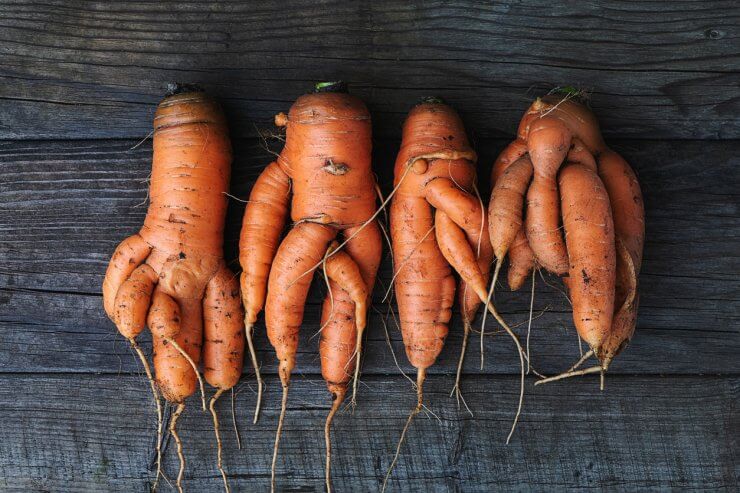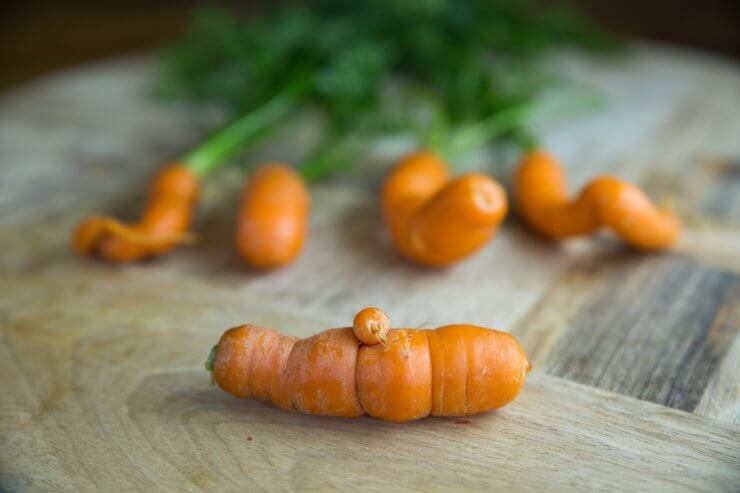
Last spring, I practiced crop rotation and moved where I generally plant my carrots to a much lower raised garden bed. Later this summer I pulled up what I thought would be a beautiful crop of Danvers carrots, only to find a tangle of twisted, forked roots that looked more like tiny orange octopi than vegetables. After years of hearing about these deformed carrots and helping countless other gardeners through similar struggles, I’ve learned that growing perfect carrots is as much about understanding what happens below the soil as it is about following basic growing instructions.
Let’s dig into the fascinating science of carrot development and learn how to work with nature to grow the carrots of your dreams.
The Underground Story: What Makes Carrots Fork and Twist
What many gardeners don’t realize is that carrots are essentially modified taproots – they’re not just storing nutrients, they’re actively searching for the easiest path through your soil. When that perfectly straight path isn’t available, deformed carrots are the result. The taproot encounters an obstacle – whether that’s a rock, hard clay layer, or even just densely packed soil – and splits into multiple growth points, creating those characteristic forks and twists.
The good news is that these shape irregularities rarely affect flavor. In fact, some of my most delicious carrots have been the wonkiest looking ones. The cellular structures that create sweetness and those distinctive carrot flavors develop independently from the root’s shape. However, severe deformities can make carrots difficult to clean and prepare, and they often lead to more waste during preparation.
The path to straighter carrots starts with understanding your soil structure. Carrots thrive in deep, loose, well-draining soil with a pH between 6.0 and 6.8. The ideal soil composition is a sandy loam – substantial enough to hold moisture and nutrients, but loose enough to allow easy root penetration. Clay soils are particularly challenging because they compact easily and can form hard layers that force roots to split or twist.
Before you reach for the rototiller though, consider this: aggressive tilling can actually make soil structure worse over time by destroying the natural aggregates that create good drainage and aeration. Instead, I recommend a gentler, more sustainable approach to soil improvement.

Building Better Soil for Perfect Carrots
After years of experimentation, I’ve found that the most effective soil amendment strategy involves working with your soil’s natural properties rather than fighting against them. Start by adding organic matter in the form of well-decomposed compost – this improves both clay and sandy soils by enhancing structure and water retention. For particularly challenging soils, consider creating raised beds or deep containers specifically for root crops – this is what I’ve done for all my years of carrot-growing and I have always grown beautiful carrots until I mixed it up this year!
If you’re dealing with rocky soil that produces deformed carrots, try this technique: create a trench about 18 inches deep and fill it with a mixture of screened topsoil, compost, and a small amount of sand. This gives carrots the perfect runway for straight growth without requiring you to amend your entire garden.
A often-overlooked factor in carrot development is consistent moisture. Irregular watering can cause carrots to split or develop unusual shapes as they alternate between growth spurts and survival mode. A 2-3 inch layer of light mulch helps maintain even soil moisture and prevents the soil surface from forming a crust that can impede seedling emergence.
Before planting, prepare your carrot bed by loosening the soil to at least 12 inches deep, removing any rocks or debris you encounter. Space your rows about 16 inches apart to allow for proper root development. When thinning seedlings (an essential step for preventing deformed carrots), aim for about 2-3 inches between plants. This gives each carrot the space it needs to develop properly without competition from its neighbors.
And if you are still having trouble, or can’t make these amendments, consider growing round varieties like Parisian Market or stubby types like Oxheart. These varieties naturally grow shorter and wider, making them perfect for shallower soils or containers. They’re also less likely to develop deformities since they don’t need to push as deep into the soil.
And for a complete guide to carrot cultivation, including detailed soil preparation techniques and variety recommendations, be sure to check out our comprehensive Carrots Gardening Guide.
Remember, whether your carrots come up straight as arrows or wonderfully weird, the joy of growing your own food is about more than just perfect produce. Each deformed carrot teaches us something about our soil and helps us become better gardeners.
We’d love to hear about your experiences growing carrots! Have you found creative solutions for dealing with challenging soil conditions? Share your success stories and lessons learned in the comments below.


 Previous
Previous

